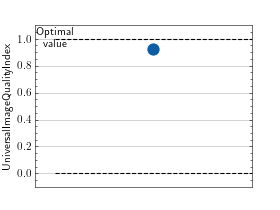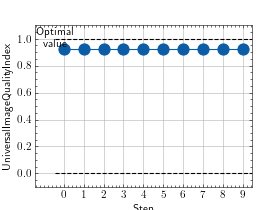Universal Image Quality Index¶
Module Interface¶
- class torchmetrics.image.UniversalImageQualityIndex(kernel_size=(11, 11), sigma=(1.5, 1.5), reduction='elementwise_mean', **kwargs)[source]¶
Compute Universal Image Quality Index (UniversalImageQualityIndex).
As input to
forwardandupdatethe metric accepts the following inputpreds(Tensor): Predictions from model of shape(N,C,H,W)target(Tensor): Ground truth values of shape(N,C,H,W)
As output of forward and compute the metric returns the following output
uiqi(Tensor): ifreduction!='none'returns float scalar tensor with average UIQI value over sample else returns tensor of shape(N,)with UIQI values per sample
- Parameters:
sigma¶ (
Sequence[float]) – Standard deviation of the gaussian kernelreduction¶ (
Literal['elementwise_mean','sum','none',None]) –a method to reduce metric score over labels.
'elementwise_mean': takes the mean (default)'sum': takes the sum'none'orNone: no reduction will be applied
kwargs¶ (
Any) – Additional keyword arguments, see Advanced metric settings for more info.
- Returns:
Tensor with UniversalImageQualityIndex score
Example
>>> import torch >>> from torchmetrics.image import UniversalImageQualityIndex >>> preds = torch.rand([16, 1, 16, 16]) >>> target = preds * 0.75 >>> uqi = UniversalImageQualityIndex() >>> uqi(preds, target) tensor(0.9216)
- plot(val=None, ax=None)[source]¶
Plot a single or multiple values from the metric.
- Parameters:
val¶ (
Union[Tensor,Sequence[Tensor],None]) – Either a single result from calling metric.forward or metric.compute or a list of these results. If no value is provided, will automatically call metric.compute and plot that result.ax¶ (
Optional[Axes]) – An matplotlib axis object. If provided will add plot to that axis
- Return type:
- Returns:
Figure and Axes object
- Raises:
ModuleNotFoundError – If matplotlib is not installed
>>> # Example plotting a single value >>> import torch >>> from torchmetrics.image import UniversalImageQualityIndex >>> preds = torch.rand([16, 1, 16, 16]) >>> target = preds * 0.75 >>> metric = UniversalImageQualityIndex() >>> metric.update(preds, target) >>> fig_, ax_ = metric.plot()

>>> # Example plotting multiple values >>> import torch >>> from torchmetrics.image import UniversalImageQualityIndex >>> preds = torch.rand([16, 1, 16, 16]) >>> target = preds * 0.75 >>> metric = UniversalImageQualityIndex() >>> values = [ ] >>> for _ in range(10): ... values.append(metric(preds, target)) >>> fig_, ax_ = metric.plot(values)

Functional Interface¶
- torchmetrics.functional.image.universal_image_quality_index(preds, target, kernel_size=(11, 11), sigma=(1.5, 1.5), reduction='elementwise_mean')[source]¶
Universal Image Quality Index.
- Parameters:
- Return type:
- Returns:
Tensor with UniversalImageQualityIndex score
- Raises:
TypeError – If
predsandtargetdon’t have the same data type.ValueError – If
predsandtargetdon’t haveBxCxHxW shape.ValueError – If the length of
kernel_sizeorsigmais not2.ValueError – If one of the elements of
kernel_sizeis not anodd positive number.ValueError – If one of the elements of
sigmais not apositive number.
Example
>>> from torchmetrics.functional.image import universal_image_quality_index >>> preds = torch.rand([16, 1, 16, 16]) >>> target = preds * 0.75 >>> universal_image_quality_index(preds, target) tensor(0.9216)
References
[1] Zhou Wang and A. C. Bovik, “A universal image quality index,” in IEEE Signal Processing Letters, vol. 9, no. 3, pp. 81-84, March 2002, doi: 10.1109/97.995823.
[2] Zhou Wang, A. C. Bovik, H. R. Sheikh and E. P. Simoncelli, “Image quality assessment: from error visibility to structural similarity,” in IEEE Transactions on Image Processing, vol. 13, no. 4, pp. 600-612, April 2004, doi: 10.1109/TIP.2003.819861.
